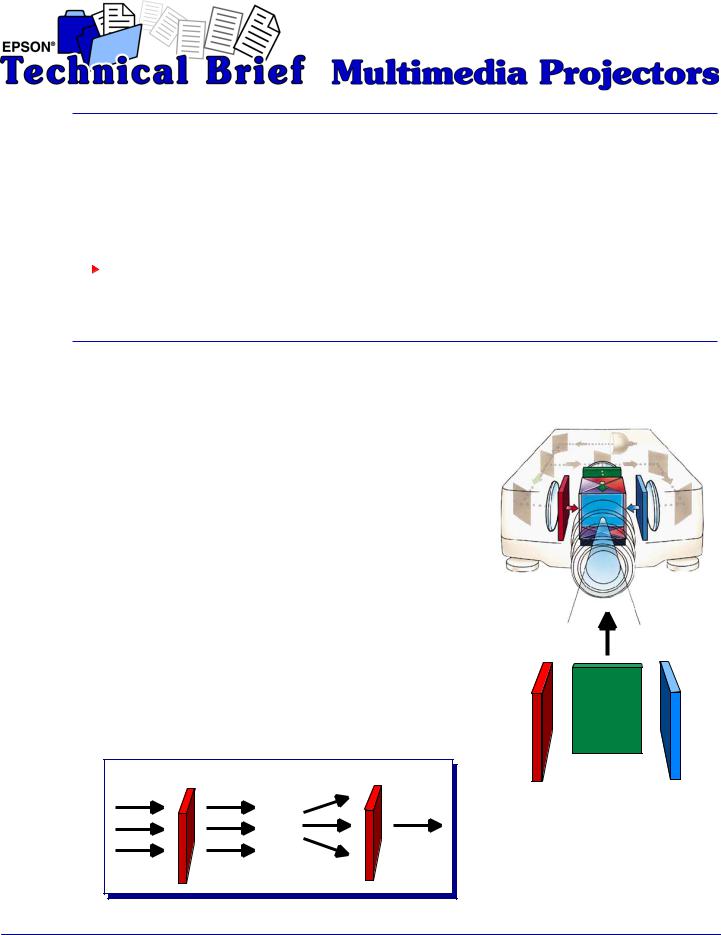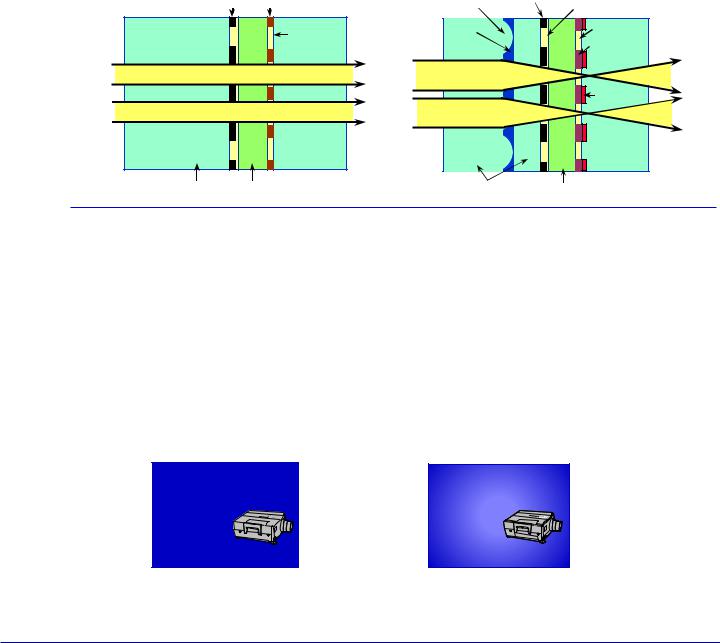Epson ELPDC04, ELP-3000, ELP-3300, ELP-3500, Crystal Image Video Technical Brief
...
 Contents
Contents
This technical brief provides detailed information on the following topics, related to all EPSON multimedia projectors:
 Image quality ▼ Brightness
Image quality ▼ Brightness
▼Image clarity
▼Keystone correction
▼EPSON SizeWise™ resizing technology
Versatility |
▼ Flexible controls |
▼ELP Link IV software
▼Flexible installation
▼EasyMP and EasyMP.net
 Image Quality—Superior brightness
Image Quality—Superior brightness
All EPSON multimedia projectors include EPSON's integrated LCD prism technology. This technology is centered
on EPSON's patented optical engine.
Three-panel design:
EPSON's engine includes 3-panel Poly-Silicon TFT LCD's:
▲ ▲
Size ranging from 1.32 inches to 0.9 inches Resolutions from SVGA to XGA to SXGA.
Improvements in the precision of this LCD structure has allowed EPSON projectors to reach a superior level of brightness with a combination of these five technologies, included in most EPSON projectors:
1. UHE lamp:
The long-life Ultra High Efficiency (UHE) lamp uses a shorter arc length. This shorter length is the primary factor in achieving higher efficiency.
2. Polarization conversion:
EPSON's technology has improved the amount of parallel light that moves through the LCD panels. More light passes through each LCD because it is polarized without a filter.
Parallel light beam |
Non-parallel light beam |
EPSON-made Poly-Silicon LCD's are manufactured to the highest standards.
EPSON Sales Training |
EPSON and EPSON Stylus are registered trademarks of Seiko Epson Corporation. |
3/01 |
|
Other trademarks are the property of their respective owners. |
|

Technical Brief—Multimedia projectors |
Page 2 |
3. High aperture LCD panels:
The UHA (Ultra High Aperture) has increased the aperture ratio which allows more light through the lens. EPSON produces the highest aperture LCD's, which are more transmissive.
4. Micro Lens Array:
MLA is a layer of the LCD composed of quartz crystal lenses. Each pixel has a dedicated lens that focuses and maximizes the throughput of light from the lamp. MLA allows more light to pass through each pixel, more than twice the light of LCD's of two years ago. (Not included on all EPSON projectors.)
5. "Metal Sandwich" technology:
A light shield of metal between the pixels blocks the light leakage. Cross-talk between pixels is reduced, resulting in clearer, crisper images. (Not included on all EPSON projectors.)
Traditional LCD structure
Traditional LCD structure
Black matrix |
TFT |
|
|
|
Pixel electrode |
Lamp light |
|
|
Lamp light |
|
|
Opposite |
|
TFT |
substrate |
|
substrate |
Optical glass |
Liquid crystal |
|
EPSON's advanced LCD technology
UHA LCD structure
(on most EPSON projectors)
Micro lens |
Black matrix |
|
ITO |
Adhesive agent |
Pixel electrode |
|
TFT |
Lamp light |
|
|
Light shield |
Opposite |
substrate |
substrate |
|
Optical glass |
Liquid crystal |
 Image quality—Image clarity
Image quality—Image clarity
EPSON projectors producte astonishingly clear, sharp images with a combination of these three technologies:
1. High illumination ratios:
The illumination ratio measures the relationship of the darkest spot (the corner) to the brightest spot on the screen (the center). The higher the ratio, the more uniform the brightness.
2. High contrast ratios:
Contrast ratio measures the difference between the light and dark areas of the image. The higher the ratio the sharper, more colorful, and more lifelike the images appear.
EPSON projectors produce |
vs. |
Competitive units can produce |
smooth, evenly lit images with |
|
"hot" centers with dark corners |
sharp contrast. |
|
and fuzzy contrast. |
EPSON
PowerLite Projectors
Award-  winning
winning 
 projectors
projectors
EPSON
Powerlite Projectors
Award- winning projectors
winning projectors
EPSON Sales Training |
EPSON and EPSON Stylus are registered trademarks of Seiko Epson Corporation. |
3/01 |
|
Other trademarks are the property of their respective owners. |
|
